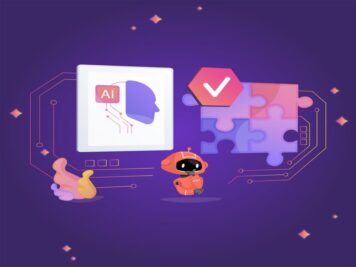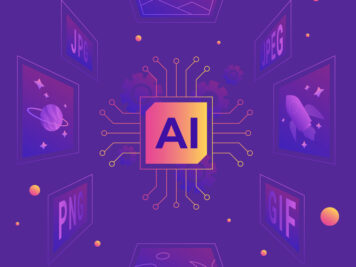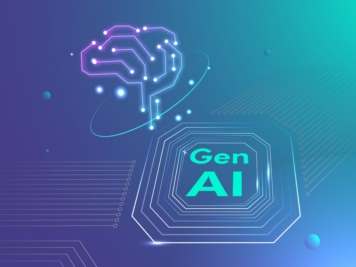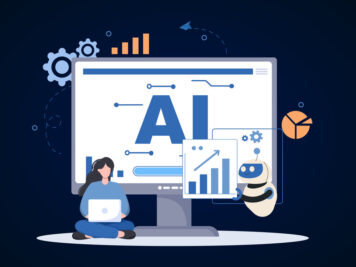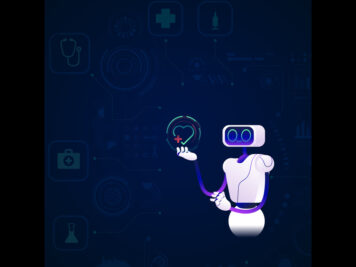In the last six years, AI adoption by businesses has hovered around 50%. This year’s McKinsey survey shows that adoption has risen to 72%, illustrating the growing use of AI across all industries. Despite this progress, for many businesses the road to effective AI application development and deployment remains a challenge.
For business leaders—owners, entrepreneurs, project managers, CTOs, and CFOs—investing in AI is a multifaceted decision. They’re not just exploring AI for a competitive edge but also to tackle challenges like reducing costs, achieving scalability, gaining data-driven insights, and automating processes with minimal risk. The questions they face: What are the best applications? How will it integrate with current systems? And what ROI can be anticipated?
Having built over 200 technology products, including AI-powered solutions, we’ve gained insights into the unique challenges and opportunities in this space. To help you unlock AI’s potential, we’ve outlined key challenges, essential considerations for AI development, and practical solutions.
Identifying and addressing AI application development challenges
AI has enormous potential, but business executives face substantial limitations. Creating a realistic approach to AI application development can be made easier by having a deep understanding of these problem areas.
High cost and ROI uncertainty
CFOs are tasked with scrutinizing the bottom line, particularly when it comes to the initial investment in AI. AI is more than just a software implementation; it needs human and financial resources to get started. And the payoff? It can be significant, but it is typically a long-term strategy, with benefits that increase as AI evolves within the company. You can also maximize the return on AI investments by working with external IT and business executives to align AI projects with organizational goals.
Talent and expertise shortage
For CTOs and hiring managers, the challenge is finding and retaining qualified experts who understand AI and can tailor it to a company’s specific requirements. The complexity of AI requires the use of specialized skill sets, such as data scientists, AI engineers, and machine learning experts, which are in high demand and expensive.
Companies can consider outsourcing as a solution to this problem. They can gain access to necessary skills and experience by working with external professionals rather than building an in-house team. This method allows companies to successfully manage expenses and resources while simultaneously translating their business goals into AI solutions.
One of our clients in the US, a well-established SaaS platform, experienced a similar condition. They were short on talent who can ship the required features in time to meet the business demands to increase open rates of their emails, reduce content creation time, and integrate an AI solution with their existing current email systems.
Our engineers worked closely with their internal team to launch a generative AI solution with DALL-E and ChatGPT. DALL-E’s artistic talent brought visually striking images to the mix, while ChatGPT produced captivating email copy. The results were remarkable. The new email format was well received by customers, and potential customers started paying attention to it.
Integration with existing system
For many, AI is analogous to putting a jet engine on an old propeller plane. Won’t it ruin everything? Will the system fail? Will processes grind to a halt? These are legitimate concerns, particularly for project managers whose job it is to keep the operations running smoothly day in and day out.
The approach is not to rip and replace, but to carefully integrate, taking steps to enhance rather than overhaul. Each phase builds on what is already working, adapting incrementally to create a more powerful whole.
Here’s a real-life example: we helped another client transition from reliance on videos and PDFs to using a chatbot as a guide. They struggled with extracting information and wanted a chatbot that could deliver swift and accurate responses. By integrating ChatGPT with their knowledgebase, we boosted their processes using semantic caching and asynchronous answer generation. This resulted in a 90% accuracy rate for summarizing answers and an over 80% success rate in providing correct video URLs.
Compliance and ethical concerns
As AI advances, so will ethical and compliance challenges. Companies must address issues such as biased algorithms and data protection as part of their AI ethics strategy.
To solve this problem, companies could create an ethical framework for AI adoption that takes into account the organization’s beliefs and ideals. This framework should be evaluated and modified periodically, with input from all stakeholders within the company.
Crafting a roadmap AI application development
With the challenges mapped out, the focus shifts to crafting a roadmap. An effective AI strategy starts not with the technology but with a clearly defined outcome in mind.
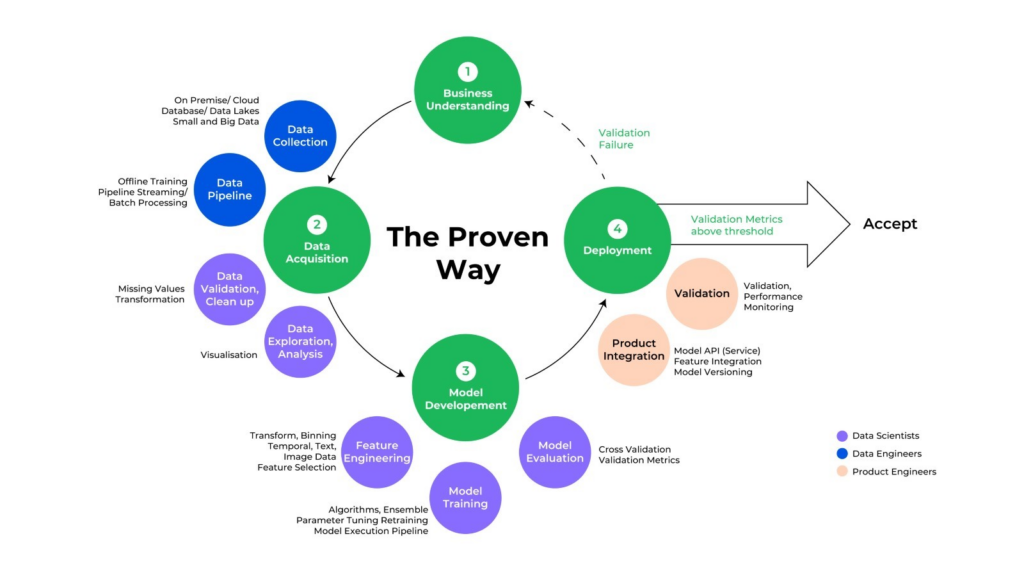
Define your goals
Preparing for AI application development involves more than just one good idea. Start by determining the goal of AI implementation:
- What do we want AI to achieve?
- Is the emphasis on customer experience, operational efficiency, predictive analytics, or something else entirely?
Defining these upfront narrows the scope, focuses resources, and serves as a guiding light throughout development.
Prepare data with precision
Data is the foundation of every AI project. Relevant, high-quality data distinguishes an effective AI application from one that fails to deliver results. Many companies start with a data audit, which involves assessing what they have, finding gaps, and developing data management standards. Data integrity, quality, and accessibility are critical. This stage often involves building robust data pipelines, managing data lakes, and in many cases, investing in data labeling and augmentation to ensure accuracy.
Such moves provide benefits with a substantial impact on the ROI. In one of our projects, we built a high-quality data set for an email marketing client. Our AI experts carefully supercharged their existing customer data, such as reviews and social media integrations, with AI-driven insights. As a result, the company started rolling out highly targeted emails with better opening rates.
Build or outsource the right skills
Data scientists, machine learning engineers, and AI project managers are all required for an in-house AI team. You’ll also need software developers to run AI solutions, data engineers to manage data infrastructure, and UX designers to provide user-friendly interfaces. Simultaneously, there should be a plan for training the tech team to keep them updated about the latest AI developments/
If building an in-house team isn’t an option, consider partnering with a specialized AI service provider. They can offer end-to-end support—from development to deployment. You’ll have the flexibility to ramp the team up or down as needed. Plus, they can train your team to enhance their skills along the way.
Select and train models thoughtfully
Selecting the right model starts with understanding your data and goals, whether it’s predicting outcomes with supervised learning or spotting anomalies with unsupervised learning. The process is iterative, with each cycle improving the model’s accuracy and relevance. Along the way, factors like data quality, scalability, and computing resources play a crucial role. Periodic evaluations with validation datasets and parameter adjustments help ensure the model stays effective over time.
In a healthcare project, we had to identify the shape of cells and detect cells under mitosis. We used classical image processing techniques for cell localization, image transformation and feature extraction. We classified cells using a trained convolutional neural network and detected similar regions in H&E-stained tissue with an unsupervised neural auto-encoder, acting as an image fingerprinting system.
Develop and deploy incrementally
Start with a minimum viable product (MVP) to validate assumptions, improve algorithms, and modify strategy when real-world data comes in. For project managers, this iterative process emphasizes cooperation between developers, stakeholders, and users, with each step building on prior learning. To reduce disruption, integrate AI applications gradually so team members can make adjustments and provide feedback. Adopt a flexible strategy and ensure that AI improves current systems without creating operational challenges.
Scale and monitor performance
Once you have a proof of concept, scale your project while observing its performance and making necessary adjustments to the AI model. Clear goals, key performance indicators, and ROI insights help guide the process. Feedback loops and periodic reviews of data and algorithms ensure ongoing accuracy, relevance, and adaptability.
AI application development is a continuous process. Agile approaches that emphasize rapid iteration (testing, learning, and fine-tuning) can be very helpful.
Tools and technique for ai application development
Tool and technique selection is a critical aspect of AI application development. For example:
| TensorFlow and PyTorch frameworks allow flexibility for custom AI models, while Google’s AutoML platform offers simpler and more scalable solutions. |
| Data processing tools like Apache Spark and Hadoop easily manage massive data sets, which is essential for most AI applications. |
| Deployment tools like Docker and Kubernetes make it easy to integrate and deploy AI models into production environments. |
| Visualization tools like Tableau and Power BI help turn AI results into useful insights, allowing stakeholders to make data-driven decisions more easily. |
Choosing the right tools and techniques requires finding a balance between complexity and functionality. Your team’s experience with these technologies, and the specific needs of your AI application can impact your decisions.
Additionally, keeping up with the latest developments in AI technology and regularly evaluating new tools can provide your AI team with a competitive advantage and improve the effectiveness of AI initiatives.
Measuring productivity: Key metrics for AI project ROI
Project managers and CFOs want measurable results to study their AI ROI. Measuring productivity during AI application development is a tricky task but it is completely unavoidable.
In AI development, productivity encompasses speed, code quality and results of the work generated. Traditional metrics do not deliver the standards required for such analyses. The impact of AI tools and techniques can only be measured with new metrics.
For example, GitHub Copilot reports significant productivity gains, with coding tasks completed 55% faster. AWS CodeDisplayer and Tabnine make similar claims, highlighting their efficiency benefits. However, the reported benefits of these tools differ depending on the maturity of the product in development: whether it is an early-stage MVP, a fast-growing product, or a stable, mature product. This variation underscores the importance of custom productivity metrics.
Our studies have shown us that productivity gains from tools such as Copilot are often not noticeable until they are used consistently over many months. Metrics such as code churn rate, which is the ratio of lines added to lines removed, can provide important insights over this period. A lower code churn rate indicates fewer revisions, better alignment with project goals, and more efficient development processes. This metric helps teams balance fast iteration with a clean, maintainable codebase.
Cycle time is another metric to consider, as it tracks how quickly features move from development to production. This metric is very useful for technical executives who want to maximize efficiency. Task complexity, scope creep, bad code, and code base all have a big impact on cycle time, making it vital for decision-makers to understand these trade-offs.
Model accuracy and precision are crucial for predictive AI algorithms. These metrics reflect the quality of code inputs and AI outputs. A well-structured, optimized codebase ensures consistent, reliable performance. By monitoring these metrics, teams can refine their models over time, maintaining relevance and performance.
For more detailed insights please refer to our webinar on: Copilot Boost Developers’ Productivity- Hype or Reality?
Crafting a cost-conscious strategy
AI’s capabilities don’t have to be prohibitively expensive. A growing number of budget-conscious companies are realizing that with strategic planning, even modest investment can have a big impact.
One strategy is to use cloud-based AI systems, which allow for scalable setups that accelerate development and keep upfront expenses modest. Similarly, open-source frameworks like TensorFlow and PyTorch provide robust tools that enable teams to build advanced AI solutions while staying within budget.
For generative AI, the calculus becomes more complex. Large language models (LLMs), in particular, need a lot of processing power and memory (think high-performance GPUs or TPUs), leading to higher operational costs as models scale or require continuous retraining. For companies with tighter budgets, striking the right balance between cost-effectiveness and model performance is essential. Third-party services, such as OpenAI, provide a practical solution with minimal upfront costs, making them ideal for early-stage projects or small applications. However, when consumption increases, so do expenses, particularly for complex or large-scale models.
At this point, open-source solutions, such as Meta’s OPT, is an attractive option. These solutions give companies greater flexibility and control over deployment, as well as the potential to reduce operational expenses.
A hybrid approach—starting with third-party services to quickly launch a project and transitioning to open-source solutions as demands increase—can help companies scale their generative AI initiatives with foresight and economy.
Equally important is the art of prioritization. Rather than spreading AI across all company functions, the sensible strategy is to focus on high-impact areas where it can bring the most value. AI-based chatbots or virtual assistants, for example, can produce immediate wins if customer service is a major issue, freeing up human agents for difficult cases that require a personal touch.
Companies that keep their initiatives focused not only make AI projects more manageable but also pave the way for future growth as resources and confidence in AI increase.
Conclusion
AI application development isn’t just a technical undertaking; it’s a strategic commitment to building a smarter, more adaptive business. Leaders need to think long-term about how AI will impact business operations, staff, and customer relationships. As AI advances, so must their strategy. Modular designs make upgrades easy, and ethical concerns are critical to building trust.
The real winners are those who view AI as a living asset that continually adapts to new requirements. They promote a culture of continuous improvement by implementing a data-driven, phased strategy. It’s more than just technology; it’s about a vision of AI that evolves and adapts while balancing innovation and responsibility.
